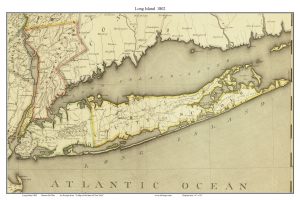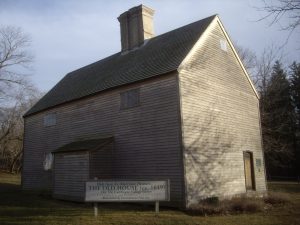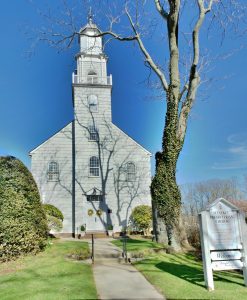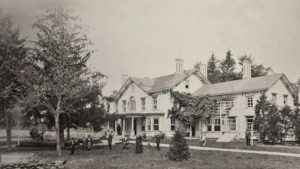
Long Island, NY was originally settled in 1640,
The very first European settlements on Long Island were by settlers from England and its colonies in present-day New England. Lion Gardiner settled nearby Gardiners Island. The first settlement on the geographic Long Island itself was on October 21, 1640, when Southold was established by the Rev. John Youngs and settlers from New Haven, Connecticut. Peter Hallock, one of the settlers, drew the long straw and was granted the honor to step ashore first. He is considered the first New World settler on Long Island. Southampton was settled in the same year. Hempstead followed in 1644, East Hampton in 1648, Huntington in 1653, Brookhaven in 1655, and Smithtown in 1665.

The Old House in Cutchogue, built 1649, is the oldest English-style house in the state.
While the English eastern region of Long Island was first settled by the English, the western portion of Long Island was settled by the Dutch; until 1664, the jurisdiction of Long Island was split between the Dutch and English, roughly at the present border between Nassau County and Suffolk County. The Dutch founded six towns in present-day Brooklyn beginning in 1645. These included: Brooklyn, Gravesend, Flatlands, Flatbush, New Utrecht, and Bushwick. The Dutch had granted an English settlement in Hempstead, New York (now in Nassau County) in 1644, but after a boundary dispute they drove out English settlers from the Oyster Bay area. However, in 1664, the English returned to take over the Dutch colony of New Netherland, including Long Island.
The 1664 land patent granted to the Duke of York included all islands in Long Island Sound. The Duke of York held a grudge against Connecticut, as New Haven had hidden three of the judges (John Dixwell, Edward Whalley and William Goffe ) who sentenced the Duke’s father, King Charles I, to death in 1649. Settlers throughout Suffolk County pressed to stay part of Connecticut, but Governor Sir Edmund Andros threatened to eliminate the settlers’ rights to land if they did not yield, which they did by 1676.
All of Long Island (as well as the islands between it and Connecticut) became part of the Province of New York within the Shire of York. Present-day Suffolk County was designated as the East Riding (of Yorkshire), present-day Brooklyn was part of the West Riding, and present-day Queens and Nassau were part of the larger North Riding. In 1683, Yorkshire was dissolved and the three original counties on Long Island were established: Kings, Queens, and Suffolk.

The oldest church now standing in Suffolk county, or in fact on Long Island, is the Caroline Episcopal church at Setauket on the north side of the Green around which the first settlement of Brookhaven was made in 1655.
This ancient building lifts heaven ward its grand old tower, while its windows look silently out upon the graves of generations of the former worshipers who have come to rest within shadow.
The earliest notice on the books of the “Society for the Propagation of the Gospel in Foreign Parts,” is of the appointment of the Rev James Wetmore as missionary in the Town of Brookhaven in 1723. It is supposed that services of the church of England were conducted here before that date, but it is not known that the church had a building of its own before the present one was erected in 1729.
The Battle of Long Island, also known as the Battle of Brooklyn and the Battle of Brooklyn Heights, was an action of the American Revolutionary War fought on August 27, 1776, at the western edge of Long Island in the present-day Brooklyn, New York. The British defeated the Americans and gained access to the strategically important Port of New York, which they held for the rest of the war. It was the first major battle to take place after the United States declared its independence on July 4, and in troop deployment and combat, it was the biggest battle of the war.
“The time is now near at hand which must probably determine whether Americans are to be freemen or slaves; whether they are to have any property they can call their own; whether their houses and farms are to be pillaged and destroyed, and themselves consigned to a state of wretchedness from which no human efforts will deliver them. The fate of unborn millions will now depend, under God, on the courage and conduct of this army. Our cruel and unrelenting enemy leaves us only the choice of brave resistance, or the most abject submission. We have, therefore, to resolve to conquer or die.”
GEORGE WASHINGTON ADDRESS TO THE CONTINENTAL ARMY BEFORE THE BATTLE OF LONG ISLAND | TUESDAY, AUGUST 27, 1776
Long Island endured 7 seven years of British Occupation, during which the British brutalized and plundered the residents of Long Island.
After 180 years of European slavery on Long Island, the region had played a pre-eminent role in the battle for independence and liberty from England, throughout the revolutionary war. While America declared its independence from England in 1776, the war that resulted from that declaration, and occupation of Long Island did not end until 1783, and within 16 years of the end of the Revolutionary war, that left the region torn, those same Long Islanders that took up the torch against English Tyranny began to end slavery in New York with the Gradual Emancipation act that freed slave children born after July 4, 1799.
While it is not commonly known, Long Island also played a major role in The Underground Railroad that helped former slaves find safety in the newly free states of America.

Long Island has had a long history as one of the earliest settlements in America, and has been on the forefront of Liberty and justice for all, since the first days of The United States of America. Many Long Islanders and New Yorkers are the decedents of men who would not ruled or enslaved, an who sought to be the sheep dogs of their day, and protect the freedoms of their fellow citizens.
We as long Islanders continue that pride and tradition, as we look forward to pushing for American freedom, and relief from a new yoke of oppression reaching forth its arm from Albany.
For all members of our Long Island community, may the blessings of God and Liberty protect you and your families.
He married Susannah, daughter of Judge Hugh Gelston of Southampton, in 1742. he was a man of considerable property as he inherited a large estate from his father, and occupied a high position in the county.
Before the revolution, Josiah Smith was a colonel of the militia, and at a meeting of the residents of the parish of South Haven on June 13, 1774, it was voted that Captain Josiah Smith, William Smith, Colonel Nathaniel Woodhull, Colonel William Floyd, Thomas Fanning, Captain David Mulford and Captain Jonathan baker, “be a standing committee for this place to correspond with the Committee of Correspondence in the city of New York.”
At a meeting of the inhabitants of Brookhaven town held on June 8, 1775, 16 persons were elected to represent the town as a Committee of Observation and “to deliberate on other matters relative to our political welfare.” Among these was Captain Josiah Smith.
When the revolution broke out, he was appointed a Colonel of the regiment of Minute Men. Early in 1776 the Continental Congress proceeded to organize four battalions for defensive purposes in the Colony of New York, and Josiah Smith, chairman, and the members of the Suffolk County committee were authorized by letters to raise three companies, “to prevent depredations on Long Island.”
On July 20, general Woodhull wrote to Colonel Smith, notifying him that Congress had called out one quarter of the militia in Suffolk, Queens and Kings counties for the defense of the stock and inhabitants of Long Island. This letter further stated that “one regiment has been made of the whole detachment, and you have been appointed to take the command of it.”
Under this authority, Colonel Smith organized the Suffolk County Regiment. The following quotation is from a historian of the battle of Long Island. “Suffolk County had early given evidence of its hearty zeal for republican doctrines. Out of its whole population of freeholders and adult male inhabitants, numbering 2,384 between the ages of 16 and 60, only 236 were reckoned as being of loyalist sympathy.
The enrolled militia of the County exceeded 2,000, of whom 393 officers and privates were in the ranks of Colonel Smith’s regiment, the best disciplined and armed on the island. It was the only one that could be considered in any form to have survived the shock of the 27th of August, (Battle of Long Island), and only a small part of this body ever did service after that fatal day.”
On August 12, 1776, Colonel Smith returned to his home in east moriches, and according to “Mather’s Refugees to Connecticut,” went to Connecticut in November, 1776, to escape the British who were in possession of Long Island at that time. he must have returned to his home sometime later as an item copied by Town Historian osborn Shaw from an old notebook of Colonel Smith (formerly in the possession of the late Riley P. Howell), states that he was seized at his home by two British soldiers on July 1, 1779, and taken to the Provost in New York, where he was kept until September 24 of that year, when he was liberated and he returned to his home.
He was treasurer of Suffolk county from 1746 until his death in 1786. He left one son and three daughters, and was buried in a corner of a field near his homestead. A Tombstone in a neighboring cemetery bears the record of his memory. This cemetery has been taken over by Brookhaven town, and will be maintained as a historical landmark.
All but one of the members of this spy ring were Setauket people. The details of the origin of the spy system are not clear, but about 1778 major Benjamin Tallmadge was head ot this organization, and reported to General Washington. Mr. Tallmadge was born in Setauket in 1754, the son of the local Presbyterian minister, and it was natural hr turned to his Setauket neighbors for help. For five years or more he and the men picked out by him operated this spy ring under the noses of the British in New York and on Long Island, without any of them ever being caught. So successful were they in concealing their idenity that General Washington never knew who the members of the spy chain were.
News of the British plans and monements were gathered in New York city by Robert Townsend, who operated a coffee shop near Wall street. he was known to General Washington only as “Culper, Jr.” Information gathered by him was taken to Setauket by messenger on horseback, who was Austin Roe of Setauket.. He in turn left it in a secret hiding place for Abraham Woodhull, who was the middleman in the spy system and went under the name of “Culper, Sr.” He turned it over to Caleb Brewster, who took it across the sound in one of his boats and delivered it to Major Tallmadge’s headquarters in Connecticut. From there it was delivered to General Washington, wherever he might be.
Robert Townsend was the chief figure on the New York city end. he posed as a young Tory merchant in partnership with james Rivington, and they operated a general merchandise store and coffee shop. mr Townsend was a well educated man, and soon became widely acquainted in british circles.
The man who carried the messages from New York to Setauket was Austin Roe. who operated a store and tavern in Setauket. Disguised as a country merchant, hr traveled back and forth without detection. it is almost impossible to realize what Austin Roe had to contend with as he rode the 55 miles from Setauket to New York through the enemy’s country, often several times a week.
If it had been possible to follow a message from New York to Setauket and across the sound to Major Tallmadge’s headquarters we might have seen Austin Roe enter Mr. Townsend’s coffee shop in new York. he was tired and hungry, for he had just finished a long ride from Setauket. When Mr. Townsend saw Mr. Roe come in he knew General Washington was expecting a message from him, so he soon left and went to his quarters nearby. he was soon followed by Austin Roe, who handed him a letter from John Bolton (Major Tallmadge) which read, “I wish you to send by bearer 1/2 ream of letter paper.” Mr Townsend paid little attention to this message but went to a secret closet and brought out a bottle of liquid which he brushed over the letter. Soon another message sprang to light on the paper. It was from General Washington, requesting certain information. In the meantime Mr. Roe had started down the street to the printing office of James Rivington, where he purchased a half ream of paper and went back to Mr. Townsend’s rooms. carefully it was unwrapped, so that it could be sealed again without showing it had been opened. Mr. Townsend began counting the sheets until he arrived at a number previously agreed on. That sheet was taken out, and Mr. Townsend, reaching for another bottle of a different liquid, began to write his message to Washington. As soon as the stain was dry it disappeared giving no hint it was there waiting to be developed by another liquid. The sheet was replaced in its proper place in the package of paper and resealed. Austin Roe packed his saddle bags with a variety of articles needed by those in the Setauket area, and set out for home, crossing the Brooklyn ferry and arriving at Setauket in time to give attention to his cattle which were kept pastured in a field belonging to Abraham Woodhull. He was a young farmer from Setauket and the middleman in the spy ring, who used his farm on Conscience bay as a base for operations. because his house was full of British Troops, he arranged for Austin Roe to pasture his cattle on his land, which gave Mr. Roe a place to hide the messages he brought from New York. Mr. Woodhull then picked up the messages from a secret box behind a fence, and latter turned them over to an exwhaler by the name of Caleb Brewster, with carried them across the sound with his boat to Major Tallmadge’s headquarters in Connecticut. In addition to this, Mr. Brewster, with his lightly armed whaleboats, captured several supply ships headed for the British army at New York, and also led his men on raids across the island, burning and wrecking whatever they could find belonging to the British. He led the attack on the British Fort St. George at Mastic in November 1780, which proved a complete success.
Long Island has had a long history as one of the earliest settlements in America, and has been on the forefront of liberty and justice for all, since the first days of The United States of America. Many Long Islanders and New Yorkers are the decedents of men who would not ruled or enslaved, an who sought to be the sheep dogs of their day, and protect the freedoms of their fellow citizens.
We as Long Islanders continue that pride and tradition, as we look forward to pushing for American freedom, and relief from a new yoke of oppression reaching forth its arm from Albany.
For all members of our Long Island community, may the blessings of God and Liberty protect you and your families
